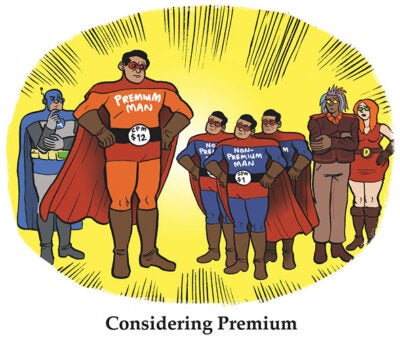The word “premium” gets thrown around a lot.
Marketers chase “premium” publishers to reach “premium” audiences. DSPs and SSPs promise “premium” inventory. And every publisher wants to sell itself as a “premium” supply.
But what exactly does “premium” mean?
It seems the definition varies depending on who’s using it – that “premium” is in the eye of the beholder. But there are some areas of agreement. And the industry isn’t setting the premium bar as high as you might think.
Publishers vs. inventory vs. sellers
There are some agreed-upon markers for what makes a premium publisher. Some publishers are labeled as premium based on their reputation, the caliber of their editorial content and the size of their audiences. Publishers that command loyalty from dedicated niche audiences can also be considered premium. And brand safety is always a consideration.
“If you check all the boxes but the content itself is risky, you’re not going to get that premium labeling, at least from mainstream advertisers,” said Jared Lansky, SVP of partnerships at MediaMath.
If audiences are willing to pay for a publisher’s content, that’s another indicator of premium status.
“Paywalls are proxies for premium,” said Nikhil Lai, senior performance marketing analyst at Forrester. “Sub-premium would be a free newspaper or public access television – something that doesn’t require anything of the user in exchange for that content.”
But marketers disagree on whether publishers themselves should be considered premium or whether the premium label should only apply to certain inventory or even certain sellers.
“There are premium sellers – Warner is a premium seller, and Outbrain is a sub-premium seller,” said Chris Kane, president of Jounce Media. “They both monetize some inventory on CNN.com. So, you can’t think about CNN.com as being premium or not.”
Intent-driven audiences often get the premium label.
“Premium connotes an audience that is actively seeking out that media experience, and there’s as little risk as possible of them not responding,” Lai said.
And brands expect to pay a premium price for premium inventory.
“The term premium is a rhetorical device that I used when I sold TV advertising. But my manager told me not to because it implies high CPMs and that would scare off prospects,” Lai said. “Now, I use premium to describe audiences rather than inventory.”
Driving performance
But, when it comes to determining what inventory counts as premium, audience intent matters a lot more than scale or CPM. That’s because most advertisers agree that premium inventory drives measurable performance.
“Premium is the same thing as performance,” Kane said. “Premium inventory has a demonstrated ability to convince consumers to buy a product.”
Sub-premium inventory delivers what DSPs are looking for: brand safety, low levels of invalid traffic (IVT), high viewability and video completion rate (VCR) and even low clearing prices. But the user experience on the site could be so bad that the ads don’t drive results or change user behavior, Kane said.
The whole point of programmatic advertising is to optimize toward performance. But there’s no consensus on what performance benchmarks need to be met for inventory to qualify as premium.
Players throughout the programmatic supply chain have tried to establish their own methods for judging the quality of ad inventory and whether it deserves a premium label.
Many SSPs promise premium inventory, but the buy side shouldn’t be expected to take the sell side’s word for what qualifies.
On the buy side, DSP are rolling out proprietary connections to premium inventory – take The Trade Desk’s OpenPath, for example. But a DSP’s criteria for premium inventory isn’t always transparent.
“I wish more DSP were doing what The Trade Desk is doing, but it’s hard to know where they draw the line on what inventory is available by default and what’s blocked by default,” Kane said. “As an industry, we need an independent arbiter of quality, and we don’t have one.”
How much inventory is really premium?
The idea of premium might bring to mind only the highest-quality, most sought-after placements. But estimates and data-driven attempts to quantify how much ad inventory should be considered premium range between one-fifth of available inventory to as much as half.
“From a gut perspective, 20%-30% [of inventory qualifies as premium],” Lansky said.
Jounce Media’s research into the topic found that, based on its criteria for driving performance and creating a user experience conducive for doing so, 49% of display inventory and 35% of video inventory falls into the premium bucket, Kane said.
So, with so much premium inventory available, why would marketers buy anything else?
“I think the only real reason is bad KPIs,” Kane said. “Media buyers are tasked with having a lower CPM and higher viewability and video completion rates than they had last year.”
The result is that advertisers often buy inventory that’s geared toward maximizing KPIs but misses in terms of performance, he said.
It’s up to marketers to decide whether they want to chase easily gamed KPIs or performance. Fortunately, despite what the name might suggest, premium inventory doesn’t seem to be in such short supply.















